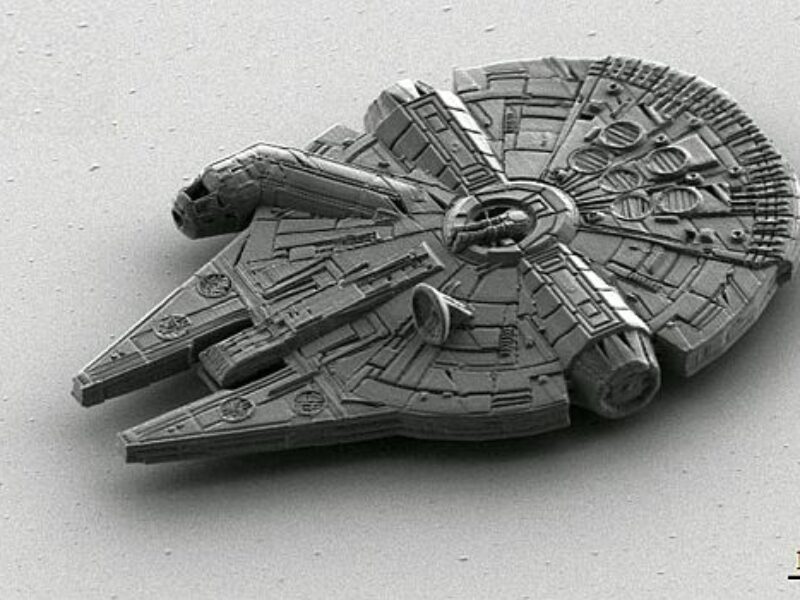
Microscopic 3D printed Millenium Falcon is 100 microns long
The craft, printed by Microlight3D in Grenoble, is 70.8micrometers wide, and 23.4micrometers high with a printing resolution of 200nm. The µFAB-3D-Advanced 3D printing system uses a new polymer material developed at the company that works with a green laser that operates at 532nm. This gives the higher resolution than traditional red laser systems.
The tiny spacecraft was printed in 50 minutes with 10 minutes in a solvent bath to develop. There was no pre-bake or post-bake, and no other post-treatment as there is no support material).
The two-photon polymerization (2PP) technology used in Microlight3D’s micro-manufacturing machines is the result of 15 years of fundamental research at the University of Grenoble Alpes (UGA). The sub-nanosecond green laser pulses are combined with a non-linear laser-polymer interaction to create ultra narrow and reproducible voxels. These can be positioned, and moved freely, anywhere in the volume of polymer.
Microlight3D has also partnered with semiconductor distributor SPS Europe in Belgium to expand into the fast-growing 2D maskless-lithography market. The deal gives the semiconductor distributor exclusive rights to market the Polos-mPrinter in Europe, with sales options in North America, Asia and beyond.
The 2D maskless lithography printer enables researchers and engineers with small budgets to design microstructures of exceptional performance. These include microsensors, microoptics, microfluidics and MEMS devices.
Currently, France and Germany represent 80 percent of Microlight3D’s 2D printing systems activities. This system, whose software and user interface make it user-friendly, has been designed to offer users greater affordability and desktop convenience.
“SPS has highly-competent sales teams that are well-established in many countries as suppliers of innovative tools and customized solutions for the semiconductor industry,” said Denis Barbier, CEO of Microlight3D. “With SPS, greater numbers of customers will have access to the Polos-mPrinter. Its affordability for researchers and industrial designers and ease of use will also become more widely recognized.”
Related 3D printing articles
- GROUP BECOMES LINUX FOUNDATION STANDARD
- PRINTING GRAPHENE FOR ELECTRONIC DEVICES
- AEROGEL MICROSTRUCTURES FOR SENSORS AND INSULATION
- SPRAYABLE DISPLAY BRINGS 3D PRINTS TO LIFE
 If you enjoyed this article, you will like the following ones: don't miss them by subscribing to :
eeNews on Google News
If you enjoyed this article, you will like the following ones: don't miss them by subscribing to :
eeNews on Google News




